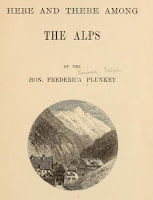Politician, diplomat, jurist, political scientist, historian and mountaineer, James Bryce was a man of many parts.
Born in a small terraced house in Arthur Street, Belfast, on 10th May 1838. He spent the first eight years of his life at his grandfather's residence on the shores of Belfast Lough. At age eleven he climbed Trostan from Cushendall and claimed it was the birth and growth of his 'lifelong passion for mountain climbing'. His schooling and academic career were extensive (see here for details). He was widely honoured, receiving the order of merit (1907) and honorary degrees from thirty-one universities, and was president of the British Academy (1913–17).
Bryce became a great mountain walker and climber, and his love of both activities was closely related to his interest in the natural world. In his early youth he spent much of his time in the mountains of Ireland and Scotland. Bryce’s notable experiences of mountain landscape combined with a particular environmentalist sensibility and political liberalism to shape his pioneering ideas about landscape preservation. His mountaineering was important to his personal identity and to his practice as an historian. Bryce’s ideas about history were influenced by an environmentalist perspective on the world, gained through on-foot experience of it.
A slim, wiry man of medium height with a crisp purposeful walk and piercing deep-set eyes, Bryce exuded a sense of energy, liveliness, and movement; his pursuit of knowledge was incessant, his interests ranging over geology, botany, history, politics, law, and philosophy. He carried his great learning lightly and was happy with life's simple pleasures: smoking his pipe, reading, a good walk, or a brisk swim.
.JPG) |
| N Face Mt Bryce. Wikipedia |
From 1862, when he spent a semester in Heidelberg University, he climbed the classics of Switzerland and Italy including Monte Rossa, Streckhorn Monte Pelmo and Marmolata. In 1866, with Leslie Stephen, he climbed in the Carpathians (Monte Csalho). In 1872 he was in Iceland but seems not to have been impressed by the mountains there - 'in Switzerland....the difficulty is getting to the top of your peak. In Iceland it is getting to its bottom', requiring long , tedious journeys. In 1873 he was in the Pyrenees, climbed with Henry Russell, and climbed Maladetta, Vignemale, Pic de Nethou and Canigou. In 1876 he was the first European to climb Mount Ararat in Turkey. In 1878 he was in Tatras in Carpathia and climbed a number of summits. Elected to membership of the Alpine Club in 1879 and its president from 1899 to 1901 (in John Ball's footsteps). In 1889 he was instrumental in the formation of the Cairngorm Club, the oldest and one of the largest hillwalking and climbing clubs in Scotland.
 |
| Mt Bryce. Wikipedia |
Bryce Canyon in Utah is not named in his honour, but for Ebenezer Bryce.
Mount Bryce in the Canadian Rockies was named in his honour by J Norman Collie in 1898 - the 15th highest peak in British Columbia.
Go to Home for full site map





